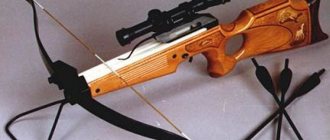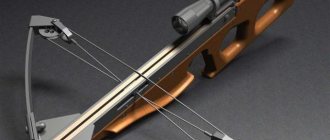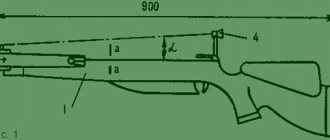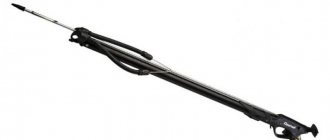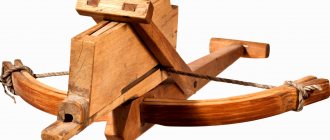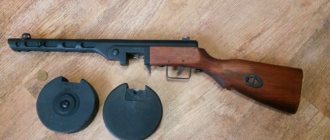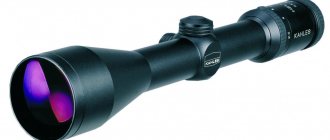Introduction to weapons
Wow.
The prototype of the modern multi-shot crossbow was the ancient Chinese weapon cho-ko-nu. Historians trace its origins to Zhuge Liang, a Chinese general from the 2nd century AD. This fact is confirmed by excavations of military graves.
The specimens found by archaeologists were branded by different manufacturers, but had interchangeable parts. This means that the production of this type of weapon has been put on stream.
Cho-ko-nu works on the same principle as a single-shot crossbow.
- He has a stock, a bow and a string for throwing arrows.
- It is distinguished by the ability to fire many shots in a row without reloading, as well as a special lever that is responsible for tensioning the bowstring and placing the arrow into the stock guide.
- Before shooting, the lever is moved all the way away from itself, and the arrow is fed into the crossbow stock.
- By moving the bowstring towards you, the crossbow is ready for battle.
Hunting for a drone
The armored vehicles were successfully tested by army special forces in southern Russia. Now a fundamental decision has been made to arm other special forces and reconnaissance units with Tigers with Arbalet-DM combat modules, sources in the Ministry of Defense told Izvestia. This year they will go to the Central and Western Military Districts.
In 2020, the military department reported the use of such armored vehicles by a special forces group in the Krasnodar Territory against drones from a distance of up to 1.5 km. The exercises took place in July during a large-scale surprise inspection of the troops of the Southern Military District.
After the completion of the Caucasus-2020 strategic exercises, the head of the Main Armored Directorate, Major General Sergei Bibik, announced that the delivery of additional Tiger-M multi-purpose vehicles with Arbalet-DM remote-controlled combat modules to the Armed Forces is planned for 2022.
“Poseidon” to the rescue: testing of Russian strategic weapons begins
An underwater drone and a new rocket will reach the finish line this year
A special feature of the module with a 12.7 mm heavy machine gun is its complete stabilization, which allows targeted fire not only from a standstill, but also while the vehicle is moving. The software makes it possible to automatically acquire and track air and ground targets. Using the Crossbow, enemy armored personnel carriers can be detected and identified within 2.5 km during the day, and 1.5 km away at night.
“Both here and abroad, the problem of protection against small drones is still not resolved,” military expert Vladislav Shurygin told Izvestia. “They are too small a target for man-portable anti-aircraft missile systems, and they can only be shot down with conventional small arms if the devices are at close range. The range of special “anti-drone” guns for jamming UAV communication channels is also limited.
A heavy machine gun with auto tracking and good optics is a practical option for fighting multicopters. For special forces and reconnaissance, which often operate independently and outside the coverage zone of military air defense, such universal vehicles capable of fighting both air and ground targets are especially relevant, the expert believes.
Russian “Field”: the complex will protect Siberia and the Urals from drones and missiles
Electronic warfare means can suppress signals over an area of hundreds of square kilometers
How the weapon works
A repeating crossbow has both advantages and disadvantages.
Advantages and disadvantages
Rate of fire and multiple charges. Modern models have a drum with arrows. While a regular crossbow fires one shot, a semi-automatic rapid-fire one fires 10-15 arrows. Ancient devices had a special box for charges, which was located above the weapon stock. In the process, the arrows simply dropped down, ensuring the rate of fire.
Automatic reloading and bowstring tensioning. They are brought into combat readiness with one movement of the hand. To do this, the movable shoulder of the crossbow is moved all the way to the side. At the same time, the drum with arrows turns, and the trigger catches the bowstring. This function can also be performed by a special lever.
Compactness. Thanks to the movable arms, the crossbow can be folded compactly. Some products have a retractable stock. This makes transportation easier.
Easy to use. No long training required. One hand turns the lever, the other squeezes the trigger.
Short range. The bowstring tension cannot be too tight, otherwise the shooter will physically not be able to reload. Because of this, the speed and range of the arrow decreases.
Low accuracy. When firing multiple shots, the weapon produces recoil in the hand, making it difficult to aim accurately. In ancient copies, this was also hampered by a massive charge box.
Low penetration ability. Due to the low flight speed and lightness of the arrows, the penetration ability is reduced. Among experts in such weapons, one can come across the opinion that if you strengthen the crossbow with metal parts, this will increase the penetrating power. But such a device will be too heavy and inconvenient to use.
Long reload time. After releasing all arrows, the crossbow requires reloading. And to send 10-15 arrows into the drum, you need to spend time.
"Tigers" with "Crossbows"
In 2017, the special forces of the Southern Military District were the first to receive a new version of the AMN 233114 Tiger-M armored vehicles with the Arbalet-DM remote-controlled combat module. Previously, there were no well-armed versions of the popular armored car in the army.
Equipped with the Crossbow, the Tiger-M is designed to guard convoys on the march, cover troop deployment areas and conduct reconnaissance. A heavy machine gun can fight not only against aerial targets. It is capable of effectively hitting infantry and light armored vehicles. In addition, the combat module is equipped with a means of setting up aerosol smoke screens. It is controlled from inside the cabin and does not interfere with the transport of nine people.
In addition to the combat module, the AMN differs from conventional Tigers by the installed Russian turbocharged diesel engine YaMZ-5347-10. The hood was armored for protection from shelling. A body made of welded steel sheets protects the crew and military personnel from fire from AKM and AK-74 assault rifles from any direction.
Tiger armored vehicles in more than 30 modifications are supplied not only to the Ministry of Defense, but also to other law enforcement agencies. And the version with the Arbalet-DM module is now no longer the most heavily armed.
An option to equip the Tiger with an even more impressive combat module with a 30-mm automatic cannon was developed and tested. There is also a project for a light self-propelled mortar system “Gorets” based on a popular armored car.
The Coalition is in the lead: long-range howitzers will be sent to the south
The latest self-propelled artillery guns fire over 70 km
Do-it-yourself repeating crossbow
Crossbow: main components.
Things to consider before starting work:
- It is necessary to make drawings of the product.
- The basis of a repeating crossbow, as in a regular one, is a stock with a guide.
- Shoulders can be either movable or stationary.
- The most difficult thing to manufacture is a multi-charge drum.
- All parts must be carefully adjusted; the slightest discrepancy will make the device impossible to operate.
The sequence of actions when making a double-shot crossbow from stainless steel:
- Make a sketch of the future crossbow and a drawing of the details.
- Cut out the parts on a piece of stainless steel.
- Cut the blanks with a grinder and sand them.
- Weld the handle, guide tube, magazine.
- Make a slot for the trigger.
- Weld a support pad for the springs (arms) to the edge of the guide, and make 2 threads in the pad.
- Drill holes in the spring for the pad.
- Connect the pad to the spring with bolts. Crossbow: drawing.
- Cut the trigger with a hook for the bowstring.
- Weld the magazine to the body.
- Make the bowstring from a metal cable.
- For the reloading mechanism, two stainless tubes are taken, which are inserted into the holes of a small metal box. The lever is activated by pulling towards itself.
- Tightly braid the handle with nylon thread.
- You can make a pressure spring for bolts (arrows).
This device can be used for hunting and fishing.
Sequence of actions from tensioning the bowstring to shooting without video instructions
The sequence of actions is simple:
- Load arrows into the drum.
- Turn the tensioner lever all the way towards you (or to the side if the shoulder serves as the lever). The lever must engage the trigger rod.
- Turn the lever all the way in the opposite direction. At the same time, the arrow lies in the stock and the bowstring is pulled.
- You can press the trigger.
Combat crossbows of our days
For obvious reasons, crossbows cannot now act as military small arms. Even firearms are now entirely automatic. The exception is samples of a rather specific, one might say, niche application such as sniper rifles. A pistol is generally a separate story: “a pistol is a personal weapon of defense and attack at short distances” (in a more frivolous presentation - “shoot your wife, your wife’s lover and shoot yourself”). And even then, if the commander of a tank regiment was forced to take on it, then it means the matter is at sea...
But for special forces, pistols, sniper rifles, and various kinds of “silent” weapons are truly in demand devices. It is there that we can meet - finally! - long-awaited crossbows (as well as “Combat pneumatics”). We’ll talk about their area of application a little later, but now the most interesting and tasty part.
Models of combat crossbows
Let’s immediately make a reservation that it is unlikely that we will be able to find a military-industrial complex enterprise anywhere on the planet that specializes in the production of “combat crossbows.” It just doesn't make sense. Here in the photo is a modern “TAC Elite” from the famous American company PSE Archery.
The name is deciphered as follows: “Tactical Assault Crossbow” - that is, “Tactical Assault Crossbow”. Moreover, the design is based on AR-15 rifle components. It would seem that this is it, they have found a real military model!.. But this is not entirely true.
Its slightly different predecessor, the TAC-15, introduced 10 years ago, produced a then-monstrous 405 fps (feet per second), or 123 m/s! Which actually had a “military” version, which even accelerated a heavy 430-grain arrow to 125 m/s. It hasn’t gone away – that’s what we now see in the picture under the name “TAC Elite”. If you have an amount of approximately 160 thousand rubles, there are no obstacles to the purchase, you will not need a Green Beret service ID :)).
It’s just that a lot of time has passed since 2008, and competitors did not sleep, including ultra-high-speed models in their production lines that are freely sold on the civilian market. Among them you can find completely budget models, for example, made in Taiwan, naturally, incomparable in terms of engineering sophistication and quality with the world's top models, and the price of the issue is completely different. In the photo - “Ballistic 410”:
You can read more about it in our post, let’s just say that it really produces 410 fps (125 m/s), albeit with lighter arrows, and in the Russian version under the name “Reaper 410” it costs only about 35 thousand rubles. the MK-XB58 “Kraken” , which entered the market a little later, ended up costing 25 thousand!
The TAC-15, like the TAC Elite, has a frank disadvantage that is not very inspiring to people in uniform - a very complex original design. They shoot with special arrows, somewhat reminiscent of archery ones. Moreover, the lock hook almost completely copies the archery release...
...and the shelf is one-on-one archery “Whisker”, it is also “hairy” :)).
By the way, quite recently the TAKs got another competitor, the Ravin R15 (pictured below), which produces 130 m/s with a much lower pull force, albeit with a 400-grain projectile.
It is also terribly complicated in design, but at least you can use regular arrows. Read more about it on our website in the article “RAVIN crossbows - uniqueness, power and accuracy.” And in the summer of 2018, the Ravins had a kind of analogue - the famous archery released a new model of the Stealth NXT crossbow:
In general, the last two or three years have been marked by the release of several models of crossbows that stand out from the orderly ranks of their quite classic counterparts. Moreover, there is a clear trend towards the creation of compact/ultra-compact powerful hunting models (see “Wonderful are your deeds, crossbow-archery world!”). It would seem that this is happiness! But new items are unlikely to replenish RAV warehouses, since miniaturization was achieved primarily, again, by complicating the design.
After all, customers from the defense departments of any country are quite conservative people. They understand perfectly well that in a real combat situation, the technological delights of small arms are essentially a good thing, but overall reliability, even indestructibility, and the comparative simplicity of mechanics, its maintenance and repair are still more important.
So why fence the garden!? And in the few, alas, photographs of real modern crossbow warriors, we see ordinary hunting models, which are distinguished by an excellent reliability-accuracy-power ratio. This is, for example, an old compact Devastator...
...the much more famous “Horton Legend” (by the way, it was his brother who was used by Daryl Dixon in the first episodes of “The Walking”):
Or the most popular both all over the world and among Russian shooters “Barnett”, “Ten Point”, etc.
And if the conditions of a special operation are approaching extremes, then the best choice is light, simple as nails, and reliable recursives. Mainly Canadian crossbows, or their Asian clones.
Of the latter, there are essentially two options on our market - the Taiwanese “Desert Hawk” (in the Russian version - “Mongoose”) and the Chinese “Lancelot”, also known as “Ranger”, “Raptor”, etc. (on the picture):
Well, it seems like we've sorted it out. It's time to move on to the scope of use of the considered samples.
The use of crossbows in the army and special services
So, as stated at the beginning, we leave out of consideration the purely army option - well, throwing weapons do not work in modern realities. Even from around the corner you can’t shoot at the adversary’s back, since his protective equipment is not designed for that. But special forces still use them. Now let's see how and why they do this.
So, what immediately comes to mind: silently “shooting” terrorists at fairly long distances, removing a sentry... Well, and - remember Rambo - defeating structures, vehicles, and even armored vehicles with the help of “explosive” or “thermite” tips :)) . Although we’ll leave the latter to cinema, let’s focus on real options.
That would be all well and good, but a crossbow arrow does not have a stopping effect as such. In real battles of antiquity and the Middle Ages, opponents managed to fight, literally riddled with arrows, and retreated due to lethal blood loss. By the way, modern crossbow and archery hunting is based on this principle, where razor-sharp tips simply cut blood vessels.
That is, death does not come immediately (if at all), which means that both the “terrorist” and the “sentinel” are quite capable of taking certain, and completely unnecessary, actions - pressing the button of the demolition machine, raising the alarm, etc. (See “Bow, crossbow, pneumatics: fakes, injuries, crime...”). A targeted shot in the larynx or left eye is, you see, more a matter of luck, which no specialist would rely on.
In addition, crossbows are not at all silent; the clap or click of a bowstring can be heard quite well, especially with recurve models (although not as loud as any firearm with a PPBS - “silencer”). And long distances at which it will not be distinguishable, alas, are not for crossbows - for hunting, their sights are aimed at 20-30-40-50, a maximum of 60 meters, and the optimal working distances are even up to 30, a maximum of 40 meters. Moreover, we are talking about getting into the kill zone, the diameter of which reaches tens of centimeters - what a larynx that is...
Now imagine a special forces soldier who, in addition to the already heavy equipment and weapons, will also drag a crossbow with him into the jungle for the sake of a hypothetical shot at some deaf-blind sentry. Although there are exceptions (pictured is a Philippine special forces soldier):
This is despite the fact that the domestic standard VSS “Vintorez” will work perfectly at distances of up to 200 meters, “Val” - up to a hundred, and at short distances pistols equipped with PBS will be no less successful. The noise level, of course, will be a little higher, but the stopping effect of the 9x39 cartridge is simply not comparable to arrows. There are also absolutely terrible models that can sit a bear on its ass, like the 12.7-mm VSSK “Vykhlop”, SHAK-12 or the RSh-12 assault revolver (see the article “Large-caliber small arms, or “We need a bigger gun...”) . Their ammunition, by the way, also has armor-piercing versions (pictured on the left) - this applies to personal armor protection equipment.
Yes, modern crossbows produce “muzzle energy” of 120-180 joules, “TAS Elite” and generally 200, but this energy is needed to give the arrow the speed necessary for maximum penetration, that is, penetrating ability. The best option is to pass the projectile right through, causing profuse bleeding on both sides of the animal’s body.
This is what the wound channel looks like when shooting an arrow into ballistic gel
An arrow (bolt) is indeed capable of crushing and piercing even solid bones, for example, the scapula, but it is far from the scale of “destruction” of a bullet. In a gunshot, a through wound, on the contrary, is not welcome - all these many hundreds and thousands of joules are intended to remain in the victim’s body, causing lethal damage to internal organs. Water hammer, literally tearing the insides, temporary pulsating cavities (pictured below), several times larger than the diameter of the wound channel itself, do not leave the animal/man a chance. And the speed of bullets in pistols is several times higher, and in long-barreled samples they are sometimes an order of magnitude higher than those of arrows, which, in principle, are not able to provide a real painful shock.
However, combat crossbows do have their own niche of use in the army and special services. We are talking mainly about countries, let’s say, that cannot boast of modern silent means of killing. With the help of an arrow, you can spank from an ambush some unwary rebel in a loincloth and armed with a machete and an ancient karamultuk. Well, or a heated “dissenter” in a balaclava, waving a vessel with a Molotov cocktail in the crowd. Why in the crowd? An arrow is still not as dangerous for strangers as a rifle bullet, and even with the possibility of ricochets.
According to some reports, in a number of countries, including India, until recently, crossbows with poisoned arrow tips were used (and may still be used). Of course, again, not in the army.
Although the PLA uses arrow throwers, albeit as an auxiliary weapon, quite en masse.
After all, China, no matter what they say, is not a country from the “golden billion”. Again, we believe that we are not talking about purely military use, but rather in suppressing potential riots and other unrest, to which army units are involved without any regard for “international public opinion.”
However, the local special forces are also not far behind:
But the main area of use of crossbows relates, rather, to technical support. Take a look at the photo.
These are crossbow fighters of the infantry units of the Peruvian army. It is not difficult to guess what their weapons are intended for. These are essentially line throwers, that is, devices that allow you to use an arrow, say, to throw a thin cord across a gorge, behind which you can then pull up a paracord and organize a crossing. Of course, such a task would be handled much better by specialized pneumatics, such as the domestic line thrower “Filin” (pictured below) or the even more powerful “Ista-240”, capable of throwing a cat with a cable not a couple of tens of meters, but hundreds, some horizontally, some at an angle, some vertically.
And yet, as we see, even in Europe, crossbows did not leave the military-historical arena along with the “wild geese” of medieval Genoa. And who knows, maybe they will be in great demand if any of the Apocalypse scenarios come true, because their undeniable advantage is the renewability of ammunition. Let’s end the story on this optimistic-pessimistic note. Although no...
To accomplish many of the goals and objectives described above, it is quite possible to do without bulky crossbows or pneumatic devices; a slingshot will be enough. Only not quite an ordinary one, but a hunting SlingBow. Details in the article “Hunting and sporting bow-slingshot“.
Attention: if handled carelessly, not only a hunting crossbow, but even a “children’s entertainment” crossbow can pose a threat to the life and health of others, and even the shooter himself (for details, see the article “Bow, crossbow, pneumatics: fakes, injuries, crime...”). Be careful.
By the way, what about combat crossbows in Russia?
Very little is known about them, but perhaps it is worth quoting the words of the head of the Ryazan Higher Airborne Command School, Major General Anatoly Kontsevoy, as he said on the Russian News Service radio station:
“The cadet must master more than 28 types of modern weapons of domestic and foreign production, and at the same time learn to use such proven means in battle as a scout knife, crossbow, bow, ax, and spatula.” That is, we also consider throwing weapons more as an auxiliary tool.
Safety precautions
A repeating crossbow is a dangerous weapon, so all safety requirements must be strictly observed.
- It is prohibited to point weapons at people or animals.
- The device is considered charged from the moment the bowstring is pulled.
- Even if the weapon is not loaded, pulling the trigger is strictly prohibited.
- The bowstring is pulled when the weapon is pointed towards the target and after the instructor's command.
- It is forbidden to shoot up and empty.
- You cannot use arrows from other devices.
- You can open fire only after making sure that there are no people or animals in the line of fire.
- It is prohibited to transfer a cocked weapon from hand to hand or leave it unattended.
- Before use, it is necessary to check the functionality.
- Store only in a discharged state.

